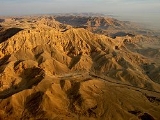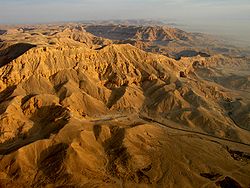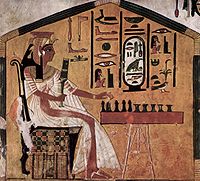
Valley of the Queens
Encyclopedia

Egypt
Egypt , officially the Arab Republic of Egypt, Arabic: , is a country mainly in North Africa, with the Sinai Peninsula forming a land bridge in Southwest Asia. Egypt is thus a transcontinental country, and a major power in Africa, the Mediterranean Basin, the Middle East and the Muslim world...
where wives of Pharaoh
Pharaoh
Pharaoh is a title used in many modern discussions of the ancient Egyptian rulers of all periods. The title originates in the term "pr-aa" which means "great house" and describes the royal palace...
s were buried in ancient times. In ancient times, it was known as Ta-Set-Neferu, meaning –‘the place of the Children of the Pharaoh’, because along with the Queens of the 18th
Eighteenth dynasty of Egypt
The eighteenth dynasty of ancient Egypt is perhaps the best known of all the dynasties of ancient Egypt...
, 19th
Nineteenth dynasty of Egypt
The Nineteenth Dynasty of ancient Egypt was one of the periods of the Egyptian New Kingdom. Founded by Vizier Ramesses I, whom Pharaoh Horemheb chose as his successor to the throne, this dynasty is best known for its military conquests in Palestine, Lebanon, and Syria.The warrior kings of the...
and 20th dynasties
Twentieth dynasty of Egypt
The Eighteenth, Nineteenth, and Twentieth Dynasties of ancient Egypt are often combined under the group title, New Kingdom. This dynasty is considered to be the last one of the New Kingdom of Egypt, and was followed by the Third Intermediate Period....
(1550–1070 BCE) many princes and princesses were also buried with various members of the nobility. The tombs of these individuals were maintained by mortuary priests who performed daily rituals and provided offerings and prayers for the deceased nobility.
The valley is located near the better known Valley of the Kings
Valley of the Kings
The Valley of the Kings , less often called the Valley of the Gates of the Kings , is a valley in Egypt where, for a period of nearly 500 years from the 16th to 11th century BC, tombs were constructed for the Pharaohs and powerful nobles of the New Kingdom .The valley stands on the west bank of...
, on the west bank of the Nile
Nile
The Nile is a major north-flowing river in North Africa, generally regarded as the longest river in the world. It is long. It runs through the ten countries of Sudan, South Sudan, Burundi, Rwanda, Democratic Republic of the Congo, Tanzania, Kenya, Ethiopia, Uganda and Egypt.The Nile has two major...
across from Thebes
Thebes, Egypt
Thebes is the Greek name for a city in Ancient Egypt located about 800 km south of the Mediterranean, on the east bank of the river Nile within the modern city of Luxor. The Theban Necropolis is situated nearby on the west bank of the Nile.-History:...
(modern Luxor
Luxor
Luxor is a city in Upper Egypt and the capital of Luxor Governorate. The population numbers 487,896 , with an area of approximately . As the site of the Ancient Egyptian city of Thebes, Luxor has frequently been characterized as the "world's greatest open air museum", as the ruins of the temple...
) . This barren area in the western hills was chosen due to its relative isolation and proximity to the capital. The kings of the 18th dynasty, instead of the traditional building of pyramids as burial chambers (perhaps because of their vulnerability to tomb robbers
Grave robbing
Grave robbery, grave robbing, or tomb raiding is the act of uncovering a tomb or crypt to steal artifacts or personal effects. Someone who engages in this act is a grave robber or tomb raider...
), now chose to be buried in rock-cut tombs.
This necropolis
Necropolis
A necropolis is a large cemetery or burial ground, usually including structural tombs. The word comes from the Greek νεκρόπολις - nekropolis, literally meaning "city of the dead"...
is said to hold more than seventy tombs, many of which are stylish and lavishly decorated. An example of this is the resting place carved out of the rock for Queen Nefertari
Nefertari
Nefertari also known as Nefertari Merytmut was one of the Great Royal Wives of Ramesses the Great. Nefertari means 'Beautiful Companion' and Meritmut means 'Beloved of [the Goddess] Mut'. She is one of the best known Egyptian queens, next to Cleopatra, Nefertiti and Hatshepsut...
(1290–1224 BCE) of the 19th Dynasty. The polychrome
Polychrome
Polychrome is one of the terms used to describe the use of multiple colors in one entity. It has also been defined as "The practice of decorating architectural elements, sculpture, etc., in a variety of colors." Polychromatic light is composed of a number of different wavelengths...
reliefs in her tomb are still intact.
Principal burials

- QV8 Hori, King's Son (18th dynasty) and a King's Daughter
- QV17 Merytre and Wermeryotes, princesses (18th dynasty)
- QV30 Nebiri, Head of the Stables unknown danasty
- QV33 Princess Tanedjmet (19th or 20th dynasty)
- QV38 Queen SitreQueen SitreQueen Sitre or Tia-Sitre was the Great Royal Wife of Pharaoh Ramesses I of Egypt and mother of Seti I.There is some debate around the identity of Ramesses' wife and Seti's mother...
, wife of Ramesses IRamesses IMenpehtyre Ramesses I was the founding Pharaoh of Ancient Egypt's 19th dynasty. The dates for his short reign are not completely known but the time-line of late 1292-1290 BC is frequently cited as well as 1295-1294 BC...
(19th dynasty) - QV42 PareherwenemefPareherwenemef (20th dynasty)Pareherwenemef was an ancient Egyptian prince of the 20th dynasty, a son of pharaoh Ramesses III. Just like several of his brothers, he was named after a son of Ramesses II, whom Ramesses III tried to emulate . He is depicted in his father's mortuary temple at Medinet Habu...
, son of Ramesses IIIRamesses IIIUsimare Ramesses III was the second Pharaoh of the Twentieth Dynasty and is considered to be the last great New Kingdom king to wield any substantial authority over Egypt. He was the son of Setnakhte and Queen Tiy-Merenese. Ramesses III is believed to have reigned from March 1186 to April 1155 BCE...
(20th dynasty) - QV43 Seth-her-khopsef, son of Ramesses III, later king as Ramesses VIII. Was buried elsewhere. (20th dynasty)
- QV44QV44QV44 is one of several tombs located in the Valley of the Queens intended for the use of Ramesses III's sons. The painted reliefs decorating Khaemwaset E's tomb illustrate his ritual and symbolic journey in the Afterlife as he meets the main gods of that region as well as the genies who guard the...
KhaemwasetKhaemwaset (20th dynasty)Khaemwaset or Khaemwase was an Ancient Egyptian prince, a son of Pharaoh Ramesses III. His name can also be found as Ramesses Khaemwaset....
, son of Ramesses III (20th dynasty) - QV46 Imhotep, vizier under Thutmose IThutmose IThutmose I was the third Pharaoh of the 18th dynasty of Egypt. He was given the throne after the death of the previous king Amenhotep I. During his reign, he campaigned deep into the Levant and Nubia, pushing the borders of Egypt further than ever before...
(18th dynasty) - QV47 Princess AhmoseAhmose (princess)Ahmose was a princess of the seventeenth dynasty of Egypt. She was the only known daughter of Tao II the Brave by his sister-wife Sitdjehuti. She was the half-sister of Pharaoh Ahmose I....
, daughter of Tao II the BraveTao II the BraveSeqenenre Tao II, , called The Brave, ruled over the last of the local kingdoms of the Theban region of Egypt in the Seventeenth Dynasty during the Second Intermediate Period. He probably was the son and successor to Senaktenre Tao I the Elder and Queen Tetisheri...
and SitdjehutiSitdjehutiSitdjehuti called Satibu was a princess and queen of the late Seventeenth dynasty of Egypt. She was a daughter of Pharaoh Senakhtenre Tao I and Queen Tetisheri and wife to her brother Seqenenre Tao II...
(17th dynasty) - QV51 Queen Iset Ta-HemdjertIset Ta-HemdjertIset Ta-Hemdjert or Isis Ta-Hemdjert, simply called Isis in her tomb, was an Ancient Egyptian queen of the twentieth dynasty; the Great Royal Wife of Ramesses III and the Royal Mother of Ramesses VI....
, wife of Ramesses III, mother of Ramesses VIRamesses VIRamesses VI was the fifth ruler of the Twentieth dynasty of Egypt who reigned from 1145 BC to 1137 BC and a son of Ramesses III by Iset Ta-Hemdjert...
(20th dynasty) - QV52 Queen TytiTytiTyti was an ancient Egyptian queen of the 20th dynasty. It was uncertain which pharaoh was her husband, but he can now only be Ramesses III based on new evidence published in the 2010 issue of the Journal of Egyptian Archaeology . Her titles shown that she was the daughter, sister, wife and mother...
(19th or 20th dynasty) - QV53 Prince Ramesses, son of Ramesses III (20th dynasty)
- QV55 Prince Amun-her-khepeshefAmun-her-khepeshef (20th dynasty)Amun-her-khepeshef was the eldest son and appointed heir of Pharaoh Ramesses III. Like many of his brothers, he was named after a son of Ramesses II, Amun-her-khepeshef. He died when he was about fifteen years old....
, son of Ramesses III (20th dynasty) - QV60 Queen NebettawyNebettawyNebettawy was an Ancient Egyptian princess and queen, the fifth daughter and one of the eight Great Royal Wives of Pharaoh Ramesses II.-Life:...
, daughter of Ramesses II (19th dynasty) - QV66QV66QV66 is the tomb of Nefertari, the Great Wife of Ramesses II, in Egypt's Valley of the Queens. It was discovered by Ernesto Schiaparelli in 1904...
Queen NefertariNefertariNefertari also known as Nefertari Merytmut was one of the Great Royal Wives of Ramesses the Great. Nefertari means 'Beautiful Companion' and Meritmut means 'Beloved of [the Goddess] Mut'. She is one of the best known Egyptian queens, next to Cleopatra, Nefertiti and Hatshepsut...
, wife of Ramesses II (19th dynasty) - QV68 Queen Meritamun, daughter of Ramesses II and Nefertari (19th dynasty)
- QV70 Nehesy (18th dynasty)
- QV71 Queen BintanathBintanathBintanath was the firstborn daughter and later Great Royal Wife of the Egyptian Pharaoh Ramesses II.-Family:Bintanath was likely born during the reign of her grandfather Seti I. Her mother was Isetnofret, one of the two most prominent wives of Ramesses II...
, daughter of Ramesses II and IsetnofretIsetnofretIsetnofret was one of the Great Royal Wives of Pharaoh Ramesses II and was the mother of his heir, Merneptah...
(19th dynasty) - QV72 Neferhat / Baki (18th dynasty)
- QV73 Queen Henuttawy? (possibly dated to the 20th Dynasty)
- QV74 Queen (Dua)Tentopet
- QV75 Queen HenutmireHenutmireHenutmire was an Ancient Egyptian princess and queen, one of the eight Great Royal Wives of Pharaoh Ramesses II.-Life:She is possibly the third and youngest child of Seti I and Queen Tuya, and the younger sister of Ramesses II and Princess Tia. This theory is based on a statue of Queen Tuya, now in...
, daughter or sister of Ramesses II - QV76 Merytre, King's Daughter (18th Dynasty)
- QV80 Queen (Mut-)TuyQueen TuyaQueen Tuya was the wife of Pharaoh Seti I of Egypt and mother of Princess Tia, Ramesses II and perhaps Henutmire. She was the daughter of Raia who was a military officer based on his title of Lieutenant of the chariotry...
, wife of Seti I and mother of Ramesses II. - QV81 Heka[...] (18th Dynasty)
- QV82 Minemhat and Amenhotep, King's Sons (18th Dynasty)
- QV88 Ahmose, King's Son (18th Dynasty)
Other burials
Fragments of burial equipments were found for several additional members of the royal family. No known tombs exist for these individuals but the existence of the burial equipment suggests that these people may have once been buried in the Valley of the Queens as well.- King's Wife Henut. Mid 18th Dynasty. Her name was enclosed in a cartouche on canopic fragments.
- Prince MenkheperreMenkheperre (prince)Menkheperre was a prince of the Eighteenth dynasty of Egypt, one of two known sons of Pharaoh Thutmose III and his Great Royal Wife Merytre-Hatshepsut...
, Son of Tuthmosis III and Merytre Hatshepsut. Canopic fragments were found. - King's Great Wife NebetnehatNebetnehatNebetnehat was an ancient Egyptian queen consort during the mid-18th dynasty. She was the Great Royal Wife of an unidentified pharaoh...
. Mid 18th Dynasty. Her name was enclosed in a cartouche on canopic fragments. - King's Daughter Ti. Mid 18th Dynasty. Canopic fragments were found.
Further reading
- Bunson, Margaret. "Valley of the Queens." Encyclopædia of Ancient Egypt. New York. (1991)

